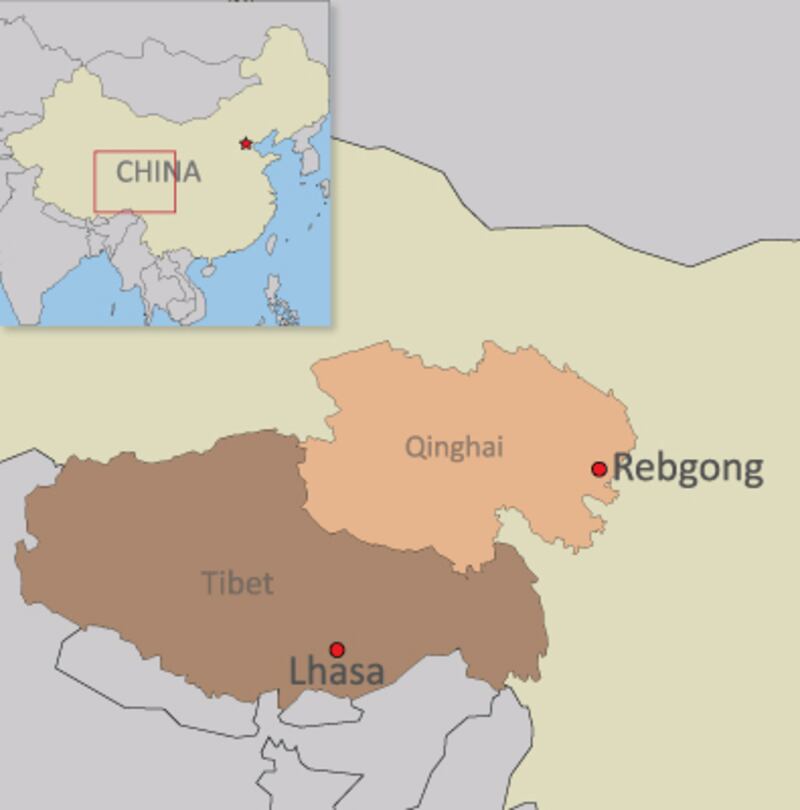Updated at 1:25 p.m. EST on 2012-11-09
Several thousand Tibetan students took to the streets in restive Rebgong (in Chinese, Tongren) county in Qinghai province Friday demanding greater rights following a record number of self-immolation protests against Chinese rule in Tibetan populated areas this week, sources said.
The students shouted slogans calling for "equality of nationalities and freedom of languages" and demanding the return of Tibet's spiritual leader the Dalai Lama, who has been living in exile in India since he fled after a failed uprising against Chinese rule in 1959, according to the sources.
Residents inside Tibet emailed photos of the demonstrations to various groups outside Tibet, with some showing students holding up Tibetan language text books.
The demonstrators from local schools, joined by students from the Malho Teacher Training College and the Malho Vocational Institute, assembled at Dolma Square in front of the Rongwo Monastery in Rongwo township, the capital of Rebgong in the Malho (Huangnan) Tibetan Autonomous Prefecture.
At the square, they recited prayers and shouted slogans as more local Tibetans joined the crowd.
Candlelight vigil

Meanwhile, almost a thousand Tibetan students from the Qinghai Nationalities University in Qinghai's provincial capital Xining gathered on Friday evening to pray for Tibetans who have died in protests challenging Chinese rule, sources said.
The students lit candles for about an hour between 6:10 p.m. to 7:20 p.m. and then dispersed after university administrators pleaded with them to end their rally.
Chinese security forces have been placed on round-the-clock duty at strategic areas in towns and villages in Rebgong but there were no reports of any clampdown of the protests, the sources said.
"I called the region and learned that around 3,000 to 4,000 students were out in the streets early this morning. They shouted slogans for the return of His Holiness the Dalai Lama, equality of nationalities, and freedom of languages," said Drugyam, a Tibetan living in exile in the U.S.
Speaking to RFA, protesters described area streets filled with Chinese security forces, plainclothes police, and military vehicles, but said that no move was made to crack down on the protests.
"A few students were beaten up, though, and some were taken to the hospital with injuries," one source said.
The India-based Tibetan government-in-exile and the Tibetan Centre for Human Rights and Democracy (TCHRD) said 5,000 students took part in the rally Friday, the second straight day of protests in Rebgong where students participated.
Chinese flags pulled down
A day earlier, as several thousand Tibetan villagers protested following the third self-immolation protest in the county this week, about 700 schoolchildren pulled down Chinese flags hoisted on top of their school building in Dowa township and in the township's government office.
"Moments after the protest, seven military trucks came from Rebgong county but local Tibetans and schoolchildren stopped the trucks from moving to Dowa township," TCHRD said in a statement, citing local contacts.
"Faced with a crowd of Tibetan protesters, the military trucks backed off, returning to Rebgong."
Rebgong was the scene of constant student protests in October 2010 against a proposed change in the language of instruction in schools from Tibetan to Chinese.
Tensions
Tensions in Rebgong had flared on Sunday when traditional artist Dorje Lhundrub, 25, burned himself to death while protesting against Chinese rule. It was followed by the fatal self-immolation of a young Tibetan mother, Tamdrin Tso, 23, on Wednesday and that of a teenage boy, Kalsang Jinpa, on Thursday.
Also on Wednesday, three teenage monks self-immolated in Sichuan province's Ngaba (in Chinese, Aba) prefecture—the first triple Tibetan burnings recorded—and another self-immolation occurred in the Tibet Autonomous Region.
The burnings have raised the self-immolation total to 69 since the fiery protests began in February 2009.
The latest protests are believed to have been timed to send a powerful signal to the ruling Chinese Communist Party which is holding its 18th Party Congress in Beijing to endorse a once-in-a-decade leadership change, Tibetan groups said.
The Central Tibetan Administration, as the Tibetan government-in-exile is called, said the self-immolations underscore "political repression, economic marginalization, environmental destruction, and cultural assimilation."
“Chinese leaders selected during the 18th Party Congress must recognize that China’s hardline policies in Tibet have utterly failed and only through dialogue can a peaceful and lasting solution be found," said Lobsang Sangay, the head of the exile government.
"We firmly believe that an end to repression will effectively end the cycle of self-immolation,” he said.
Restrictions in Lhasa
Meanwhile, Chinese authorities have tightened restrictions on the movement of Tibetans in the regional capital, Lhasa, the London-based Free Tibet advocacy group said on Friday.
"Tibetans were prevented from entering Potala Square, normally a public area."
"Unconfirmed reports also suggest that Tibetans in Lhasa were arrested as the [Party] Congress began, as a preventative measure, and that restrictions of movement have been placed on the 'old residential area' of Lhasa—where the majority of Tibetans live," Free Tibet said.
Speaking on Thursday at the Washington-based International Campaign for Tibet, Foreign Policy Initiative Director of Democracy and Human Rights Ellen Bork said that 60 years of China's "occupation and control" of Tibet have not changed what Tibetans want.
"Chinese policy over decades has not crushed Tibetan identity," Bork said.
Reported by RFA's Tibetan service. Translated by Dorjee Damdul and Rigdhen Dolma. Written in English by Parameswaran Ponnudurai and Richard Finney.
